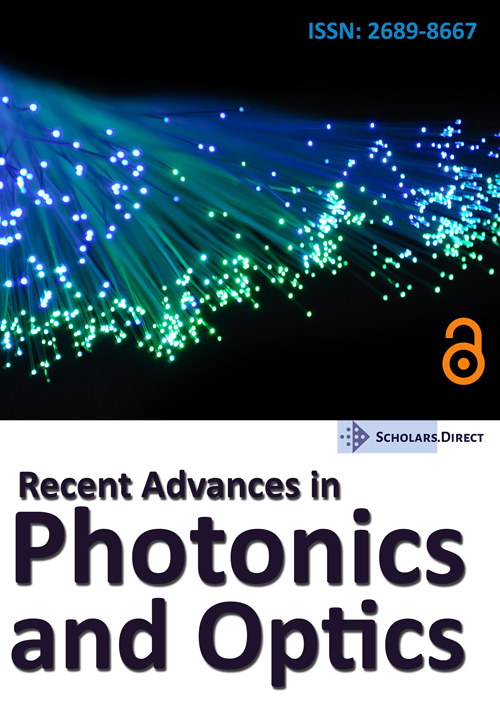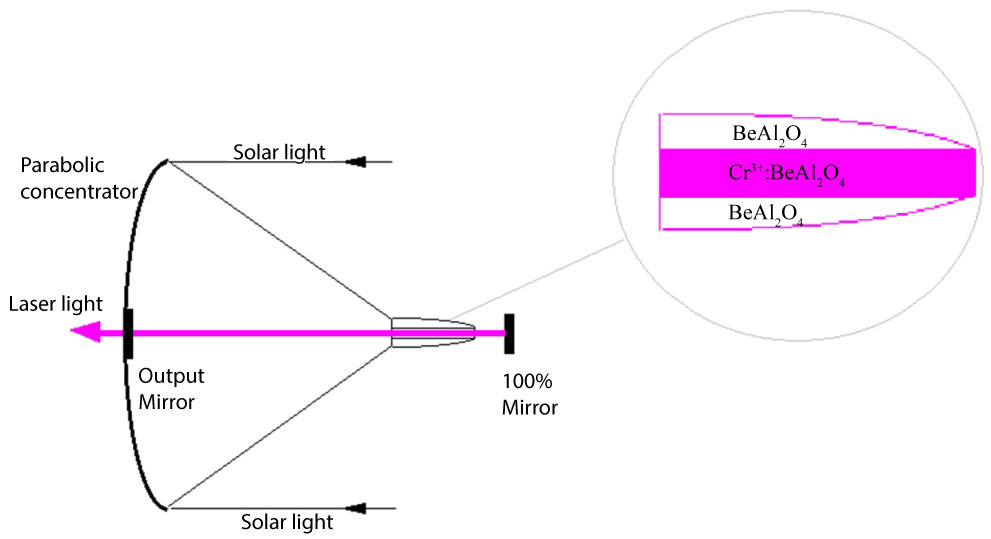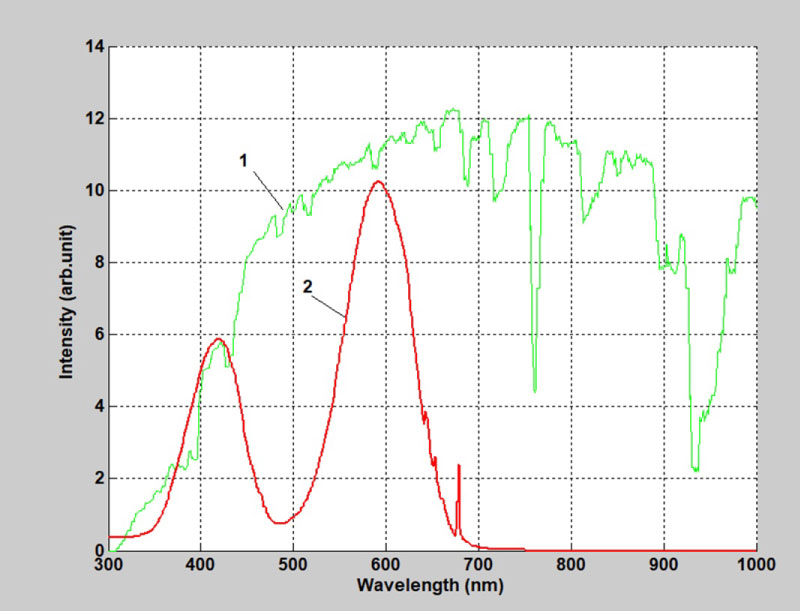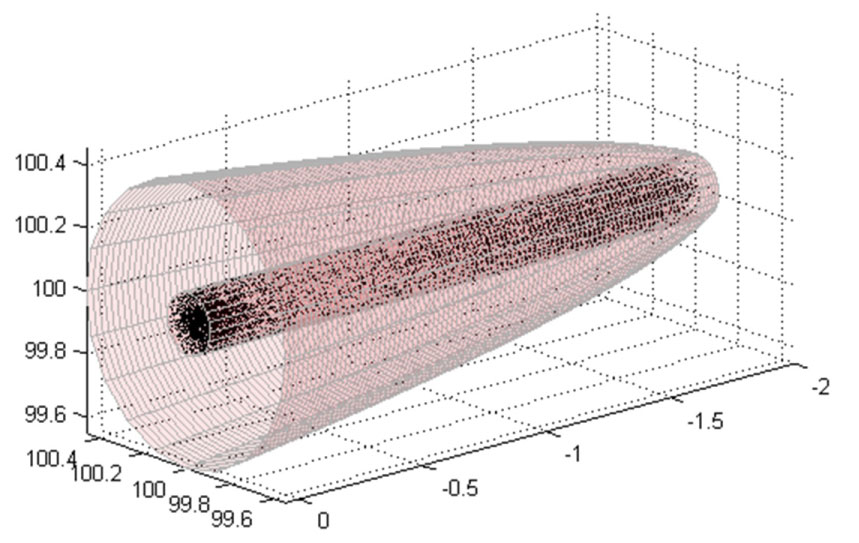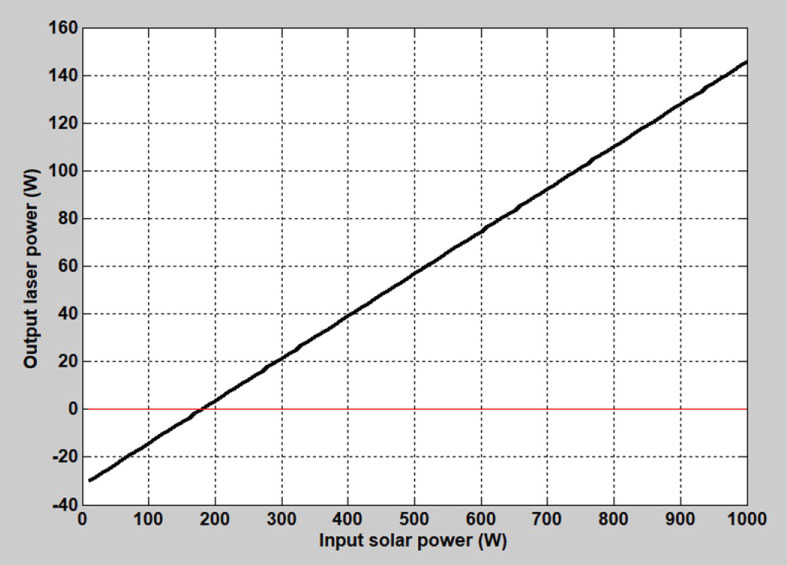Performance Analysis of Solar Pumped Alexandrite Laser: A New Way for Lowering the Threshold Power
Abstract
Simple approach for achieving high efficiency of solar pumped laser performance on the base of alexandrite active medium is proposed. Performance analyses have been conducted by simulating solar pumped alexandrite laser with core-doped parabolic shape composite active medium, using ray-tracing Monte-Carlo techniques. It is shown that the overall efficiency of alexandrite laser can be about 15% which is much higher than that of existing solar pumped lasers.
Introduction
One of the perspective ways of solar energy utilization is the solar-to-laser power conversion with the potential applications in diversity branches of industry [1-4]. However, while the other ways, such as solar-electric, solar-thermal power conversion technologies are rapidly progressing, the solar-laser power conversion still is not far from its initial stage [5]. The main problem probably is that the lasing is threshold process and requires certain conditions [6]:
- The first of such conditions is minimum concentration rate of solar radiation flux that sometimes exceeds the maximum concentration achievable, depending on laser materials used. The higher the minimum concentration required the higher the threshold power.
- The second is solving the problem connected with low-level overlap of absorption spectrum of many of existing laser materials with broadband solar spectrum.
- The third is maintenance of effective cooling, to avoid undesirable thermal effects that require the use of laser materials with high thermal conductivities.
All the enumerated conditions lead to limiting the possibility of use many of laser materials commonly used in electrical pumped lasers and are the crucial reasons why the efficiency of solar pumped lasers is still low. The maximum result for the overall solar-to-laser power conversion efficiency achieved does not exceed 5% at present [7].
To support the development of solar pumped lasers today, it is necessary to search for the new approaches, and the ideas based on recent progresses in materials science, and in other relevant topics and to demonstrate their reliability by extensive studies theoretically, experimentally, or by simulation calculations using huge resources of modern computers. The simulation calculations is often the best choice in the beginning of the technology development when it is hard to solve the problem analytically if it is necessary to determine the optimal design and performance parameters, and especially when the financial resources are limited. As described below the problem we are going to solve in this paper is the case when the simulation calculation is preferred.
In this paper we would like to share with the idea how to increase the efficiency of solar pumped lasers by the example of alexandrite as an active medium. Omitting the literature review, the whole history of solar pumped lasers, we refer to only research works that concern the alexandrite Cr: BeAl2O4. The first laser operation at room temperature from the vibronic bands of single-crystal of alexandrite (chromium-doped chrysoberyl, Cr3+:BeAl2O4) under Xe-flashlamp excitation has been obtained in 1979 [8]. Since then, this material became one of the important laser materials due to its very favorable properties. The alexandrite crystal is mechanically rigid and presents a high thermal conductivity (23 W/(mK) [9]). Its wide emission bandwidth enables broadband wavelength tuning of Alexandrite lasers in the 700-800 nm wavelength range [10,11]. Furthermore negligible concentration quenching of fluorescence [12], low passive losses (0.06%/cm [13]), high intrinsic laser slope efficiency of 65% [13], a broad absorption band around 600 nm (FWHM ~100 nm) [14], as well as a long room-temperature fluorescence lifetime (260 μs [9]) were other advantages for the efficient flashlamp or diode pumping [15]. Thus, alexandrite has been one of the most popular tunable lasers sources and used for many applications ranging from medicine [16] to differential absorption lidar [17-20]. Nevertheless, there were only a few research works on solar pumped alexandrite lasers [6,21]. In [6] 14% slope efficiency of solar-to-laser power conversion for alexandrite laser was reported based on theoretical analysis. However, the absolute minimum solar intensity that must fall on the surface of the laser material to initiate a laser was as high as 626 W/cm2, which is slightly below the maximum concentration limit of primary parabolic concentrators on the earth surface. Consequently, overall efficiency of such lasers could not be high enough. In [21] highly concentrated solar energy was obtained by a 3-stage concentrating system and an output power of up to 12 W was obtained from the alexandrite laser. But there was not any information regarding the efficiency probably because it was too low.
Thus, the main problem to solve for the alexandrite is the maintenance of high concentration conditions (the first condition above). The second and third conditions are not so critical because the factor of overlap (the fraction of solar spectrum that lies within the laser materials’ absorption bands) for the alexandrite is about 0.40 according to [6], and the thermal conductivity is as high as 23.5 W/mK, which is in 2 times higher than that for Nd:YAG. Therefore, this paper is concerned with the problem related to the first condition only.
It has been proposed different 2, 3-dimensional (2D, 3D) compound parabolic concentrators (CPC) (in particular, high refractive index CPC) for the additional increase of concentration rate of primary concentrators to provide best performance of solar pumped lasers [22-24]. The use of them would allow higher-efficiency solar-pumped lasers to be built, but the main problem was difficulty with extracting and delivering the high flux created inside the high refractive index CPC to the active medium without changes. To overcome this problem in this paper we propose to use the core doped composite active medium of parabolic shape which serves simultaneously as an active medium and CPC (Figure 1).
The laser cavity is composed of two mirrors surrounding the composite active medium, a 100% reflecting mirror to the right of the figure and a partially reflecting output mirror in the center of the parabolic concentrator. For performance analyses a MATLAB© ray-trace simulation model specific for the laser system considered was developed. The inputs to this model are "rays" chosen by a Monte-Carlo procedure [25] to characterize the focal plane spatial and directional distribution for a particular set of primary concentrator parameters. In contrast to commonly used ray trace models each ray in our model consists of one single photon that simplifies the model by eliminating the use of weighting factors when modeling of multiple reflection and refraction processes. For more the details of the model used we refer to [24-26].
Simulation Results
Simulation calculations have been conducted for 1m diameter parabolic- dish concentrator (Figure 1) with the focal length of 0.5 m. The active medium used has truncated parabolic shape as shown in Figure 1. The diameter of front end of active medium is chosen equal to the size of focal spot of the concentrator which is less than 10 mm. The length and diameter of active core of composite active medium are varied to optimize the performance parameters so that the pumping efficiency and laser output power were maximal.
In Figure 2 is presented the absorption spectrum of alexandrite and solar spectrum at the Earth surface we used in the model for determining the absorption efficiency. It was supposed that the active medium is cooled by circulating cooling water along its side surface, coated with silver with a reflectance of 97%, by commonly used ways. The cooling system does not shown in the figure. It was also supposed that both ends of an active medium are AR coated at the lasing wavelengths range 720-800 nm.
The performance efficiency tested via a Monte Carlo ray-tracing algorithm indicates that the maximum pumping efficiency of an axially symmetric parabolic shape composite active medium is 20%. Figure 3 illustrates the obtained distribution of absorbed photons inside the active core of composite active medium (black dots in the figure). The optimal diameter of an active core was 2 mm, for which we obtained about 19% pumping efficiency.
On the base of these results in the next stage we estimated the output laser power versus input solar power using well-known expression for the four-level lasers [27]:
Where is logarithmic output mirror transmission loss, 2 - total round-trip loss, - pumping efficiency, , P, - output laser, pump and threshold powers respectively. The calculations have been conducted for the output mirror reflectance of 90%. Stimulated emission cross section of 0.5 × 10-20 cm2 and the fluorescence lifetime of 260 μs [28] are used. The result is presented in Figure 4.
As it can be seen from the figure the slope efficiency is 17.5% and the overall efficiency is more than 14.5% which is several times higher than that of existing solar pumped lasers. We hope the results of this study will play important role in advancement of solar pumped lasers if they will be used in experimental studies in the future.
References
- T Yabe, T Ohkubo, T Dinh, et al. (2012) Demonstration of solar-pumped laser-induced magnesium production from magnesium oxide. In: SN Mathaudhu, WH Sillekens, NR Neelameggham, N Hort, Magnesium Technology. Springer, Cham, 55-58.
- T Yabe, S Uchida, K Ikuta, et al. (2006) Demonstrated fossil-fuel-free energy cycle using magnesium and laser. Appl Phys Lett 89: 261107-261123.
- M Lando, J Kagan, Y Shimony, et al. (1997) Solar-pumped solid-state laser program. Proc SPIE 3110: 196-201.
- Sh D Payziyev, SA Bakhramov, AK Kasimov (2011) Transformation of concentrated sunlight into laser radiation on small parabolic concentrators. JRSE 3: 053102.
- CG Young (1996) A sun pumped cw one-watt laser. Appl Opt 5: 993-997.
- M Weksler, J Shwartz (1988) Solar pumped solid state lasers. IEEE J Quantum Electron 24: 1222-1228.
- Dawei Liang, Cláudia R Vistas, Bruno D Tibúrcio, et al. (2018) Solar-pumped Cr:Nd:YAG ceramic laser with 6.7% slope efficiency. Solar Energy Materials and Solar Cells 185: 75-79.
- JC Walling, HP Jenssen, RC Morris, et al. (1979) Tunable laser performance in BeAl2O4:Cr3+. Opt Lett 4: 182-183.
- JC Walling, DF Heller, H Samelson, et al. (1985) Tunable alexandrite lasers - Development and performance. IEEE J Quantum Electron 21: 1568-1581.
- JC Walling, OG Peterson, HP Jenssen, et al. (1980) Tunable alexandrite lasers. IEEE J Quantum Electron 16: 1302-1315.
- J Kuper, T Chin, H Aschoff (1990) Extended tuning range of alexandrite at elevated temperatures. OSA Proceedings on Advanced Solid-State Lasers 56-58.
- E Sorokin (2004) Solid-state materials for few-cycle pulse generation and amplification. In: FX Kärtner, Few-cycle Laser Pulse Generation and its Applications. Springer-Verlag, 3-71.
- R Scheps, JF Myers, TR Glesne, et al. (1993) Monochromatic end-pumped operation of an alexandrite laser. Opt Commun 97: 363-366.
- N Trindade, R Scalvi, L Scalvi (2010) Cr+3 Distribution in Al1 and Al2 sites of alexandrite (BeAl2O4: Cr3+) induced by annealing, investigated by optical spectroscopy. Energy and Power Engineering 2: 18-24.
- Yorulmaz, E Beyatli, A Kurt, et al. (2014) Efficient and low-threshold alexandrite laser pumped by a single-mode diode. Opt Mater Express 4: 776-789.
- J Kozub, B Ivanov, A Jayasinghe, et al. (2011) Raman-shifted alexandrite laser for soft tissue ablation in the 6- to 7-μm wavelength range. Biomed Opt Express 2: 1275-1281.
- D Bruneau, H Cazeneuve, C Loth, et al. (1991) Double-pulse dual-wavelength Alexandrite laser for atmospheric water vapor measurement. Appl Opt 30: 3930-3937.
- D Bruneau, TA des Lions, P Quaglia, et al. (1994) Injection-seeded pulsed Alexandrite laser for differential absorption Lidar application. Appl Opt 33: 3941-3950.
- P Ponsardin, NS Higdon, BE Grossmann, et al. (1994) Spectral control of an Alexandrite laser for an airborne water-vapor differential absorption lidar system. Appl Opt 33: 6439-6450.
- SC Collins, TD Wilkerson, VB Wickwar, et al. (1997) The alexandrite ring laser: A spectrally narrow lidar light source for atmospheric fluorescence and absorption observations. In: Ansmann A, Neuber R, et al., Advances in Atmospheric Remote Sensing with Lidar: Selected Papers of the 18th International Laser Radar Conference (ILRC). Springer Berlin Heidelberg, 577-580.
- M Lando, Y Shimony, RMJ Benmair, et al. (1999) Visible solar-pumped lasers. Optical materials 13: 111-115.
- IH Hwang, JH Lee (1991) Efficiency and threshold pump intensity of CW solar-pumped solid-state lasers. IEEE Journal of Quantum Electronics 27: 2129-2134.
- P Gleckman (1988) Achievement of ultrahigh solar concentration with potential for efficient laser pumping. Appl Opt 27: 4385-4391.
- R Winston, JC Minano, P Benitez (2005) Nonimaging Optics. Elsevier Academic Press, San Diego, CA, USA.
- Sh Payziyev, Kh Makhmudov (2016) A new approach in solar-to-laser power conversion based on the use of external solar spectrum frequency converters. J Renewable Sustainable Energy 8: 015902.
- Sh Payziyev, Kh Makhmudov (2016) Solar pumped Nd:YAG laser efficiency enhancement using Cr:LiCAF frequency down-shifter. Optics Communications 380: 57-60.
- O Svelto (2010) Principles of lasers. (5th edn), Springer, New York, 620.
- JW Kuper, DC Brown (2006) High Efficiency CW Green pumped Alexandrite Lasers Proc. of SPIE 6100: 61000T.
Corresponding Author
SH Payziyev, Institute of Ion-plasma and Laser Technologies, Uzbekistan Academy of Sciences, Uzbekistan.
Copyright
© 2019 Payziyev SH et al. This is an open-access article distributed under the terms of the Creative Commons Attribution License, which permits unrestricted use, distribution, and reproduction in any medium, provided the original author and source are credited.

